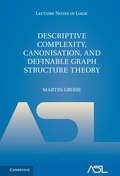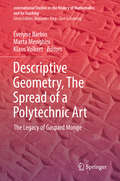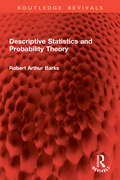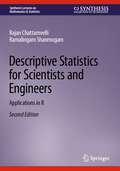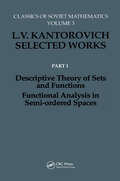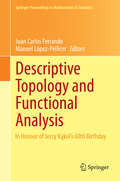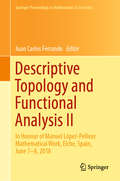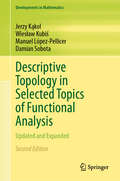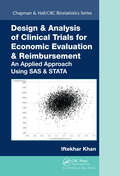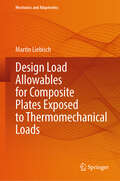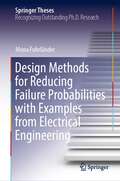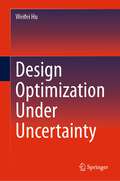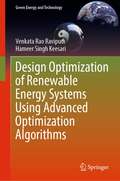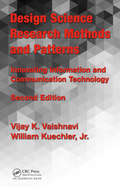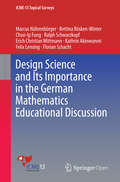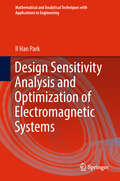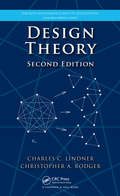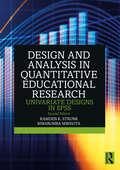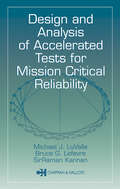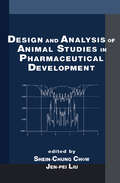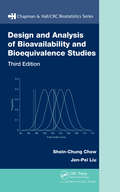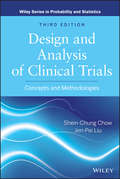- Table View
- List View
Descriptive Complexity, Canonisation, and Definable Graph Structure Theory (Lecture Notes in Logic #47)
by Martin GroheDescriptive complexity theory establishes a connection between the computational complexity of algorithmic problems (the computational resources required to solve the problems) and their descriptive complexity (the language resources required to describe the problems). This groundbreaking book approaches descriptive complexity from the angle of modern structural graph theory, specifically graph minor theory. It develops a 'definable structure theory' concerned with the logical definability of graph theoretic concepts such as tree decompositions and embeddings. The first part starts with an introduction to the background, from logic, complexity, and graph theory, and develops the theory up to first applications in descriptive complexity theory and graph isomorphism testing. It may serve as the basis for a graduate-level course. The second part is more advanced and mainly devoted to the proof of a single, previously unpublished theorem: properties of graphs with excluded minors are decidable in polynomial time if, and only if, they are definable in fixed-point logic with counting.
Descriptive Geometry, The Spread of a Polytechnic Art: The Legacy of Gaspard Monge (International Studies in the History of Mathematics and its Teaching)
by Klaus Volkert Évelyne Barbin Marta MenghiniThis book seeks to explore the history of descriptive geometry in relation to its circulation in the 19th century, which had been favoured by the transfers of the model of the École Polytechnique to other countries. The book also covers the diffusion of its teaching from higher instruction to technical and secondary teaching. In relation to that, there is analysis of the role of the institution – similar but definitely not identical in the different countries – in the field under consideration. The book contains chapters focused on different countries, areas, and institutions, written by specialists of the history of the field. Insights on descriptive geometry are provided in the context of the mathematical aspect, the aspect of teaching in particular to non-mathematicians, and the institutions themselves.
Descriptive Statistics and Probability Theory (Routledge Revivals)
by Robert Arthur BarksFirst published in 1972, in Descriptive Statistics and Probability Theory the numerical work- the selection of numerical data-is used as a basis for developing the statistical theory. Other starting points could have been chosen but a beginner will readily understand this sort of work and hence be able to ‘get the feel of’ statistics, untroubled by the learning of fresh concepts.From this numerical work emerges the ‘need’ to introduce counting techniques, permutations, combinations and the binomial theorem. In a similar way the necessity for probability is shown and the basic ideas are developed intuitively. A final short chapter shows how these ideas can be formalised within an axiomatic system. In all cases, simple intuitive ideas are taken as a starting point and then discussion leads to the final formalization. As concepts are introduced the language of statistics is developed. A large number of examples is used and they are all worked in full detail. Occasionally the reader is placed in a problem situation and invited to attempt his own individual solution before reading on to match his own attempts to other solutions. It is hoped that motivation of this sort will lead the reader to develop greater sensitivity than would otherwise be the case. This is an important read for students of statistics, mathematics and economics.
Descriptive Statistics for Scientists and Engineers: Applications in R (Synthesis Lectures on Mathematics & Statistics)
by Ramalingam Shanmugam Rajan ChattamvelliThis book introduces descriptive statistics and covers a broad range of topics of interest to students and researchers in various applied science disciplines. This includes measures of location, spread, skewness, and kurtosis; absolute and relative measures; and classification of spread, skewness, and kurtosis measures, L-moment based measures, van Zwet ordering of kurtosis, and multivariate kurtosis. Several novel topics are discussed including the recursive algorithm for sample variance; simplification of complicated summation expressions; updating formulas for sample geometric, harmonic and weighted means; divide-and-conquer algorithms for sample variance and covariance; L-skewness; spectral kurtosis, etc. A large number of exercises are included in each chapter that are drawn from various engineering fields along with examples that are illustrated using the R programming language. Basic concepts are introduced before moving on to computational aspects. Some applications in bioinformatics, finance, metallurgy, pharmacokinetics (PK), solid mechanics, and signal processing are briefly discussed. Every analyst who works with numeric data will find the discussion very illuminating and easy to follow.
Descriptive Theory of Sets and Functions. Functional Analysis in Semi-ordered Spaces (Classics of Soviet Mathematics)
by L.V. KantorovichThis book presents articles of L.V. Kantorovich on the descriptive theory of sets and function and on functional analysis in semi-ordered spaces, to demonstrate the unity of L.V. Kantorovich's creative research. It also includes two papers on the "extension of Hilbert space".
Descriptive Topology and Functional Analysis
by Juan Carlos Ferrando Manuel López-PellicerDescriptive topology and functional analysis, with extensive material demonstrating new connections between them, are the subject of the first section of this work. Applications to spaces of continuous functions, topological Abelian groups, linear topological equivalence and to the separable quotient problem are included and are presented as open problems. The second section is devoted to Banach spaces, Banach algebras and operator theory. Each chapter presents a lot of worthwhile and important recent theorems with an abstract discussing the material in the chapter. Each chapter can almost be seen as a survey covering a particular area.
Descriptive Topology and Functional Analysis II: In Honour of Manuel López-Pellicer Mathematical Work, Elche, Spain, June 7–8, 2018 (Springer Proceedings in Mathematics & Statistics #286)
by Juan Carlos FerrandoThis book is the result of a meeting on Topology and Functional Analysis, and is dedicated to Professor Manuel López-Pellicer's mathematical research. Covering topics in descriptive topology and functional analysis, including topological groups and Banach space theory, fuzzy topology, differentiability and renorming, tensor products of Banach spaces and aspects of Cp-theory, this volume is particularly useful to young researchers wanting to learn about the latest developments in these areas.
Descriptive Topology in Selected Topics of Functional Analysis: Updated and Expanded (Developments in Mathematics #24)
by Manuel López-Pellicer Jerzy Kąkol Wiesław Kubiś Damian SobotaA large mathematical community throughout the world actively works in functional analysis and uses profound techniques from topology. Written by experts in the field, this book is a treasure trove for researchers and graduate students studying the interplay among the areas of point-set and descriptive topology, modern analysis, set theory, topological vector spaces, including Banach spaces, and continuous function spaces. This second edition continues in the same spirit of the acclaimed first edition, providing new insights into the connections between the topological properties of linear function spaces and their applications in functional analysis. It has been expanded by adding completely new Chapters 17–21, presenting results concerning, but not limited to, topological spaces and groups with G-bases, various concepts related to networks and their applications in topology and functional analysis, and those that develop topological and analytic methods related to Grothendieck Banach spaces and Boolean algebras with the Nikodym property. The book will continue to serve as a reference for present and future work done in this area and could serve as a valuable supplement to advanced graduate courses in functional analysis, set-theoretic topology, or the theory of function spaces.
Design & Analysis of Clinical Trials for Economic Evaluation & Reimbursement: An Applied Approach Using SAS & STATA (Chapman & Hall/CRC Biostatistics Series)
by Iftekhar KhanEconomic evaluation has become an essential component of clinical trial design to show that new treatments and technologies offer value to payers in various healthcare systems. Although many books exist that address the theoretical or practical aspects of cost-effectiveness analysis, this book differentiates itself from the competition by detailing
Design Load Allowables for Composite Plates Exposed to Thermomechanical Loads (Mechanics and Adaptronics)
by Martin LiebischCurrent methodologies used to design lightweight structures made of CFRP materials under static thermomechanical conditions often rely on simplified approaches. In particular, the temperature-related design case is typically described by assuming a uniform distribution of the worst-case temperature, which is the maximum allowable temperature that can occur simultaneously with the mechanical loads. However, these simplifications can lead to a weight penalty due to their over-conservatism. To address these limitations, the present work describes a novel analysis methodology that accounts for spatial distributions of temperature. This approach allows for a more detailed understanding of the structural behavior under these demanding conditions. As a result, existing load-carrying potentials can be identified and used to fully exploit the advantage of CFRP structures. Moreover, this methodology generates an improved understanding of the variability in the structural behavior under such scattering thermal conditions, which can increase confidence and reliability in the design process and lead to reduce related margins of safety. To accurately model the mechanical behavior of structures at distributed temperature conditions, it is essential to consider the temperature-dependent properties of the material. These properties describing the elastic and strength behavior of the unidirectional ply, are derived from typical material characterization performed at various temperatures. In this approach, a phenomenological model is used to account for the temperature dependence of the material. This model is fitted to the characterization results to consider the individual magnitude of the properties. The resulting property allowables contain typical material uncertainties, as well as the model uncertainty that is defined by assessing the errors between the model and measurement. To determine the stability and strength behavior of structures under different thermal conditions, Finite-Element-Analysis (FEA) is utilized. Variations of thermal load distributions are analyzed to consider the uncertainty in opertational conditions qualitatively and quantitatively. A series of such analyses is conducted at different thermal conditions to determine design values such as buckling loads or failure loads. Based on this data, surrogate modeling leads to design value formulation as a function of the temperature distribution. This approach provides a more comprehensive and reliable assessment of the structural behavior under different thermal conditions and enables to either determine more realistic worst-case behavior or enhanced design values such as probabilistic structural allowables. The final part of the thesis demonstrates the developed analysis methodology on representative skin field structures. The comparison to the common analysis procedure highlights the potentials of structural load carrying capability and reveals deficiencies in the present approach. Thus, a detailed modelling of the temperature distribution leads additionally to an improved reliability of the design process and more efficient and robust structures.
Design Methods for Reducing Failure Probabilities with Examples from Electrical Engineering (Springer Theses)
by Mona FuhrländerThis book deals with efficient estimation and optimization methods to improve the design of electrotechnical devices under uncertainty. Uncertainties caused by manufacturing imperfections, natural material variations, or unpredictable environmental influences, may lead, in turn, to deviations in operation. This book describes two novel methods for yield (or failure probability) estimation. Both are hybrid methods that combine the accuracy of Monte Carlo with the efficiency of surrogate models. The SC-Hybrid approach uses stochastic collocation and adjoint error indicators. The non-intrusive GPR-Hybrid approach consists of a Gaussian process regression that allows surrogate model updates on the fly. Furthermore, the book proposes an adaptive Newton-Monte-Carlo (Newton-MC) method for efficient yield optimization. In turn, to solve optimization problems with mixed gradient information, two novel Hermite-type optimization methods are described. All the proposed methods have been numerically evaluated on two benchmark problems, such as a rectangular waveguide and a permanent magnet synchronous machine. Results showed that the new methods can significantly reduce the computational effort of yield estimation, and of single- and multi-objective yield optimization under uncertainty. All in all, this book presents novel strategies for quantification of uncertainty and optimization under uncertainty, with practical details to improve the design of electrotechnical devices, yet the methods can be used for any design process affected by uncertainties.
Design Optimization Under Uncertainty
by Weifei HuThis book introduces the fundamentals of probability, statistical, and reliability concepts, the classical methods of uncertainty quantification and analytical reliability analysis, and the state-of-the-art approaches of design optimization under uncertainty (e.g., reliability-based design optimization and robust design optimization). The topics include basic concepts of probability and distributions, uncertainty quantification using probabilistic methods, classical reliability analysis methods, time-variant reliability analysis methods, fundamentals of deterministic design optimization, reliability-based design optimization, robust design optimization, other methods of design optimization under uncertainty, and engineering applications of design optimization under uncertainty.
Design Optimization of Renewable Energy Systems Using Advanced Optimization Algorithms (Green Energy and Technology)
by Venkata Rao Ravipudi Hameer Singh KeesariThis book describes applications of Jaya and Rao algorithms on real case studies concerning different renewable energy sources.In the last few decades, researchers have focused on renewable energy resources like solar energy, bio-energy, wave energy, ocean thermal energy, tidal energy, geothermal energy, and wind energy. This has resulted in the development of new techniques and tools that could harvest energy from renewable energy sources. Many researchers and scientists have focused on developing and optimizing the energy systems to extract and utilize renewable energy more efficiently.In this book, recently developed Jaya and Rao (Rao-1, Rao-2, and Rao-3) algorithms are introduced for single- and multi-objective optimization of selected renewable energy systems. The results of applications of the different versions of Jaya and Rao algorithms are compared with the other optimization techniques like GA, NSGA-II, PSO, MOPSO, ABC, etc., and the performance of the Jaya and Rao algorithms is highlighted compared to other optimization algorithms in the case of renewable energy systems.The book also includes the validation of different versions of the Jaya and Rao algorithms through the application to complex single- and multi-objective unconstrained benchmark functions. The algorithms and computer codes of different version of Jaya and Rao algorithms are included in the book that will be very much useful to readers in industry and academic research.
Design Science Research Methods and Patterns: Innovating Information and Communication Technology, 2nd Edition
by Vijay K. Vaishnavi William KuechlerPresenting innovative research methods, this second edition of a bestseller describes a simple and practical methodology for conducting cutting-edge design science research (DSR). It provides comprehensive guidance on how to conduct such research and provides in-depth treatment of design science theory and the different types of theory that can be generated in design science research. Making novel use of the concept of patterns, it presents 84 research patterns for conducting effective DSR. It emphasizes design science theory throughout and is filled with practical examples of using patterns to conduct IT research.
Design Science and Its Importance in the German Mathematics Educational Discussion
by Marcus Nührenbörger Bettina Rösken-Winter Chun-Ip Fung Ralph Schwarzkopf Erich Christian Wittmann Kathrin Akinwunmi Felix Lensing Florian SchachtThis ICME-13 Topical Survey reviews the state-of-the-art by first exploring the roots and scope of design science. Second, it presents two examples of current design science projects that focus on substantial learning environments including a student and a teacher perspective. Subsequently, the book elaborates on how empirical research can be conceptualised within design science. Lastly, it explores developments in design science from a national and international perspective, while also discussing current trends in design research. Within the German-language tradition, considering mathematics education as a design science primarily draws on the works of Wittmann. The core of this approach constitutes designing and investigating learning environments that involve substantial mathematics. "
Design Sensitivity Analysis and Optimization of Electromagnetic Systems (Mathematical and Analytical Techniques with Applications to Engineering)
by Il Han ParkThis book presents a comprehensive introduction to design sensitivity analysis theory as applied to electromagnetic systems. It treats the subject in a unified manner, providing numerical methods and design examples. The specific focus is on continuum design sensitivity analysis, which offers significant advantages over discrete design sensitivity methods. Continuum design sensitivity formulas are derived from the material derivative in continuum mechanics and the variational form of the governing equation. Continuum sensitivity analysis is applied to Maxwell equations of electrostatic, magnetostatic and eddy-current systems, and then the sensitivity formulas for each system are derived in a closed form; an integration along the design interface.The book also introduces the recent breakthrough of the topology optimization method, which is accomplished by coupling the level set method and continuum design sensitivity. This topology optimization method enhances the possibility of the global minimum with minimised computational time, and in addition the evolving shapes during the iterative design process are easily captured in the level set equation. Moreover, since the optimization algorithm is transformed into a well-known transient analysis algorithm for differential equations, its numerical implementation becomes very simple and convenient. Despite the complex derivation processes and mathematical expressions, the obtained sensitivity formulas are very straightforward for numerical implementation. This book provides detailed explanation of the background theory and the derivation process, which will help readers understand the design method and will set the foundation for advanced research in the future.
Design Techniques for Origami Tessellations (AK Peters/CRC Recreational Mathematics Series)
by Jun Mitani Yohei YamamotoDesign Techniques for Origami Tessellations is both a collection of origami tessellations and a manual to design them. This book begins by explaining general design methods, the history and definitions of origami tessellations, and the geometric features of flat origami, before moving on to introduce a brand-new design method: the "twist-based design method." This method generates base parts that connect "twist patterns” (that can be folded with a twist) without using a lattice. Therefore, it can generate base parts such as regular pentagons, which cannot be generated with more conventional methods, and can generate new origami tessellations connected to them. Features: No proofs or formulas in the text and minimal jargon. Suitable for readers with a roughly middle school to high school level of mathematical background. Web application implementing the method described in this book is available, allowing the readers to design their own patterns.
Design Theory (Discrete Mathematics and Its Applications)
by Charles C. Lindner Christopher A. RodgerDesign Theory, Second Edition presents some of the most important techniques used for constructing combinatorial designs. It augments the descriptions of the constructions with many figures to help students understand and enjoy this branch of mathematics. This edition now offers a thorough development of the embedding of Latin squares and combinatorial designs. It also presents some pure mathematical ideas, including connections between universal algebra and graph designs. The authors focus on several basic designs, including Steiner triple systems, Latin squares, and finite projective and affine planes. They produce these designs using flexible constructions and then add interesting properties that may be required, such as resolvability, embeddings, and orthogonality. The authors also construct more complicated structures, such as Steiner quadruple systems. By providing both classical and state-of-the-art construction techniques, this book enables students to produce many other types of designs.
Design Thinking for Strategy: Innovating Towards Competitive Advantage (Management for Professionals)
by Claude DiderichThe business environment is changing more rapidly than ever before, and new business ideas are emerging. This book discusses applying insights from design thinking to craft novel strategies that satisfy customer needs, make use of the available capabilities, integrate requirements for financial success and provide competitive advantage.It guides readers through the jungle encountered when developing a strategy for sustained growth and profitability. It addresses strategy design in a holistic way by applying abductive reasoning, iteratively observing customers and focusing on empathy, as well as prototyping ideas and using customers to validate them. Uniquely applying insights from design thinking to strategy, this book is a must-read for graduates, MBAs and executives interested in innovation and strategy, as well as corporate strategists, innovation managers, business analysts and consultants.
Design and Analysis in Quantitative Educational Research: Univariate Designs in SPSS
by Kamden K. Strunk Mwarumba MwavitaDesign and Analysis in Quantitative Educational Research: Univariate Designs in SPSS presents an integrated approach to learning about research design alongside statistical analysis concepts. The authors maintain a focus on applied educational research throughout the text, with practical tips and advice on how to do high-quality quantitative research.This book teaches research design (including epistemology, research ethics, forming research questions, quantitative design, sampling methodologies, and design assumptions) and introductory statistical concepts (including descriptive statistics, probability theory, and sampling distributions), basic statistical tests (like z and t), ANOVA designs, including more advanced designs like the factorial ANOVA and mixed ANOVA, simple linear regression, and multiple regression using SPSS for analysis. Designed specifically for an introductory graduate course in research design and statistical analysis, the book takes students through principles by presenting case studies, describing the research design principles at play in each study, and then asking students to walk through the process of analyzing data that reproduce the published results. The new edition has been updated to include the latest contemporary research developments, coverage of IBM SPSS Statistics version 29, and also features new case studies, many focused on race and racism as well as other equity and justice work, and additional content on covariance and correlation. An online eResource is also available with data sets.This textbook is tailor-made for first-level doctoral courses in research design and analysis, and will also be of interest to graduate students in education and educational research.
Design and Analysis of Accelerated Tests for Mission Critical Reliability
by Michael J. LuValle Bruce G. LeFevre SirRaman KannanEarly approaches to accelerated testing were based on the assumption that there was a simple acceleration factor that would correspond to a linear scaling of time from the operating stress to the accelerating stress. This corresponds to the simplest physical model of the kinetics governing the underlying degradation, but this simple model does not
Design and Analysis of Animal Studies in Pharmaceutical Development (Chapman & Hall/CRC Biostatistics Series)
by Shein-Chung Chow"Provides well-integrated, comprehensive coverage of all the major statistical designs and methods used for animal studies in pharmaceutical research and development. Demonstrates the correct way to interpret the results of animal studies in the risk assessment of biopharmaceutical products and clarifies detailed presentations with real-world examp
Design and Analysis of Bioavailability and Bioequivalence Studies (Chapman & Hall/CRC Biostatistics Series)
by Shein-Chung Chow Jen-pei LiuPreeminent Experts Update a Well-Respected BookTaking into account the regulatory and scientific developments that have occurred since the second edition, Design and Analysis of Bioavailability and Bioequivalence Studies, Third Edition provides a complete presentation of the latest progress of activities and results in bioavailability and bioequiva
Design and Analysis of Bridging Studies (Chapman & Hall/CRC Biostatistics Series)
by Shein-Chung Chow Jen-Pei Liu Chin-Fu HsiaoAs the development of medicines has become more globalized, the geographic variations in the efficacy and safety of pharmaceutical products need to be addressed. To accelerate the product development process and shorten approval time, researchers are beginning to design multiregional trials that incorporate subjects from many countries around the w
Design and Analysis of Clinical Trials
by Shein-Chung Chow Jen-Pei LiuThe Third Edition of Design and Analysis of Clinical Trials provides complete, comprehensive, and expanded coverage of recent health treatments and interventions. Featuring a unified presentation, the book provides a well-balanced summary of current regulatory requirements and recently developed statistical methods as well as an overview of the various designs and analyses that are utilized at different stages of clinical research and development. Additional features of this Third Edition include:* New chapters on biomarker development and target clinical trials, adaptive design, trials for evaluating diagnostic devices, statistical methods for translational medicine, and traditional Chinese medicine* A balanced overview of current and emerging clinical issues as well as newly developed statistical methodologies* Practical examples of clinical trials that demonstrate everyday applicability, with illustrations and examples to explain key concepts* New sections on bridging studies and global trials, QT studies, multinational trials, comparative effectiveness trials, and the analysis of QT/QTc prolongation* A complete and balanced presentation of clinical and scientific issues, statistical concepts, and methodologies for bridging clinical and statistical disciplines* An update of each chapter that reflects changes in regulatory requirements for the drug review and approval process and recent developments in statistical design and methodology for clinical research and development. Design and Analysis of Clinical Trials, Third Edition continues to be an ideal clinical research reference for academic, pharmaceutical, medical, and regulatory scientists/researchers, statisticians, and graduate-level students.
